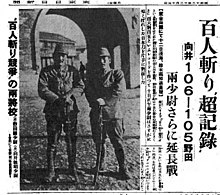
Back مسابقة لقتل 100 شخص بالسيف Arabic Hyakunin-giri Kyōsō German Concurso para matar a 100 personas usando una espada Spanish مسابقه کشتن صد نفر با استفاده از شمشیر Persian Concours de décapitation de 100 personnes French Kontes untuk membunuh 100 orang menggunakan pedang ID Gara ad uccidere 100 persone con la spada Italian 百人斬り競争 Japanese 100인 참수 경쟁 Korean വാളുപയോഗിച്ച് 100 പേരെ കൊല്ലാനുള്ള മത്സരം Malayalam

| This article is part of the series on the |
| Nanjing Massacre |
|---|
| Japanese war crimes |
| Historiography |
| Films |
| Books |
The hundred-man killing contest (Japanese: 百人斬り競争, romanized: hyakunin-giri kyōsō, Chinese: 百人斬比賽) was a newspaper account of a contest between Toshiaki Mukai (3 June 1912 – 28 January 1948) and Tsuyoshi Noda (1912 – 28 January 1948), two Japanese Army officers serving during the Japanese invasion of China, over who could kill 100 people the fastest while using a sword. The two officers were later executed on charges of war crimes and crimes against humanity for their involvement.[1]
The news stories were rediscovered in the 1970s, which sparked a larger controversy over Japanese war crimes in China, particularly the Nanjing Massacre. The modern historical consensus is that the stories did not occur as they were described.[2][3] The original accounts printed in the newspaper described the killings as hand-to-hand combat; however, historians have suggested that they were most likely a part of Japanese mass killings of Chinese prisoners of war.[4][5]
- ^ Takashi Yoshida. The making of the "Rape of Nanking". 2006, p. 64.
- ^ Fogel, Joshua A. The Nanjing Massacre in History and Historiography. 2000, p. 82.
- ^ Wakabayashi 2000, p. 307.
- ^ Honda 1999, p. 128.
- ^ Kajimoto 2015, Postwar Judgment: II. Nanking War Crimes Tribunal.